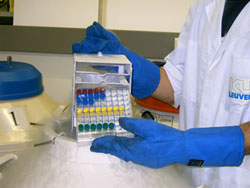Cell membranes resist freezing
Plant systems have many defence systems against threats from the environment as they are under constant bombardment from changes in weather, soil, pests and nearby competitors. Defence against freezing injury has economic importance throughout the agriculture industry. Furthermore, cryopreservation for genetic material preservation and frost resistance in crops are both areas of high economic and social significance. The overall objective of the CRYMCEPT project was to establish new methods for cryopreservation. Specifically, project partners from the Katholieke Universiteit Leuven in Belgium investigated the molecular changes in the cell membrane system on freezing. These are the primary sites of freezing injury and alterations in the biomolecular structure here hold the key to a possible underlying mechanism. In particular, they focused on alterations brought about by sucrose pre-treatment and, or desiccation. These particular procedures are implemented to ensure the survival of many plant species on preservation. The scientists discovered that these treatments resulted in changes in bound sterols, phospholipids and free fatty acids. The team concluded that application of sterols and fatty acids during the preculture stage could therefore enhance the post thaw regeneration after cryopreservation. Pharmaceutical and agricultural industries, together with any concern interested in the preservation of genetic material, could all benefit from these advancements. The protection of the genetic heritage of our planet is likely to hinge on our ability to preserve and regenerate the genetic integrity of many species that are under the threat of extinction.



